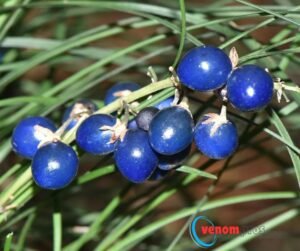
Juices of Death: A Gripping Exploration of the Venomous Fruits that Blend Sweetness with Lethality
In the vast world of flora, where nature crafts its masterpieces, there exist fruits so beguiling in appearance and taste that they could easily lure the unsuspecting into a fatal embrace. These fruits, with their radiant colors and tantalizing aromas, hold a deadly secret—venom coursing through their flesh. The paradox of something so sweet, so natural, yet so perilous, is what makes these “juices of death” both fascinating and terrifying. This article embarks on a journey to explore the fruits that blend sweetness with lethality, offering a glimpse into the world of venomous delights in Venomous Fruits.
The Allure of Nature’s Poisonous Bounty
Nature, in its complexity, often presents a duality where beauty masks danger. Some fruits, while nourishing, have evolved to protect themselves from predators with potent toxins. These fruits serve as a stark reminder that the line between sustenance and poison is thin. The following fruits, though some are rare and exotic, share a common trait: they embody this dichotomy, offering a taste of sweetness laced with the bitter aftertaste of death.

Manchineel: The Little Apple of Death
The Manchineel tree (Hippomane mancinella), found in the Caribbean, Central America, and northern South America, is notorious for its small, apple-like fruits. Nicknamed “The Little Apple of Death,” these green fruits resemble a sweet treat, but they are laced with a deadly toxin. Consuming even a small bite can cause severe blistering of the mouth and throat, intense gastrointestinal distress, and, in extreme cases, death in Venomous Fruits.
The tree itself is so dangerous that even standing beneath it during rain can cause severe skin irritation due to the toxins present in its sap.
The Cerbera Odollam: Suicide Tree’s Deadly Fruits
This tree produces small, green fruits that, while not particularly sweet, have a deceptive mildness that hides the presence of cerberin—a potent cardiac glycoside. This toxin interferes with the heart’s ability to pump blood, leading to fatal arrhythmias.
Cerbera odollam has a notorious history as a tool for suicide and murder, particularly in regions where the tree is abundant. The fruit’s blandness masks its danger, making it an ideal candidate for those with lethal intentions in Venomous Fruits.

Yew Berries: Death in a Red Cloak
The yew tree (Taxus spp.) is common in Europe, Asia, and North America, and it produces small, red berries that are both alluring and toxic. While the flesh of the berry is not poisonous, every other part of the plant, including the seed within the berry, contains taxine—a compound that is highly toxic and can cause cardiac arrest if ingested.
The dual nature of yew berries—seemingly harmless on the outside but deadly within—makes them one of the most insidious fruits in nature. The bright red color of the berries acts as a siren’s call to curious animals and humans alike, yet within lies a seed that can stop a heart in Venomous Fruits.

Ackee: The Fruit that Kills and Nourishes
The ackee fruit (Blighia sapida) is a staple in Jamaican cuisine, where it is prized for its buttery texture and mild flavor. However, this fruit is not without danger. Vomiting Sickness.”
Ripe ackee is safe and nutritious, making it a crucial part of the diet in regions where it grows. This dichotomy between safety and danger depending on the ripeness of the fruit underscores the delicate balance that must be struck when dealing with potentially lethal foods in Venomous Fruits.
Strychnine Tree: Bittersweet Death
Venomous Fruits
The Strychnine tree (Strychnos nux-vomica), native to India and Southeast Asia, produces a small, orange fruit that contains seeds filled with strychnine—a highly toxic alkaloid. Strychnine affects the central nervous system, leading to muscle convulsions and eventual death due to asphyxiation.
Despite its deadly nature, strychnine has been used in small doses as a medicine and pesticide. The fruit of the Strychnine tree represents the ultimate paradox: a natural substance that can both cure and kill, depending on the dosage in Venomous Fruits.
The Fine Line Between Life and Death
The fruits discussed above serve as a potent reminder of nature’s duality. They are a testament to the fine line between nourishment and poison, between life and death. In many cultures, these fruits are revered and feared, symbols of the power that nature wields over humanity.
These “juices of death” are not just cautionary tales; they are also a reminder of the importance of knowledge and respect when interacting with the natural world. In some cases, these fruits have been harnessed for their toxic properties, used in traditional medicine, or even as instruments of justice or murder. In others, they remain a deadly temptation, a sweet taste that could be the last.
The fruits that blend sweetness with lethality are a reminder that the line between life and death is often as thin as the skin of a fruit in Venomous Fruits.
Also read this;>The Secret Life of Urban Wildlife: Survival in the Concrete Jungle
Also read this;>“Tom Cruise Shocks the World with Death-Defying Stadium Roof Jump at Olympics Closing Ceremony!”







